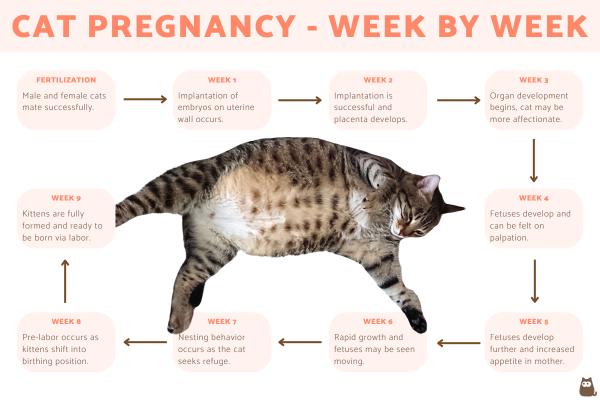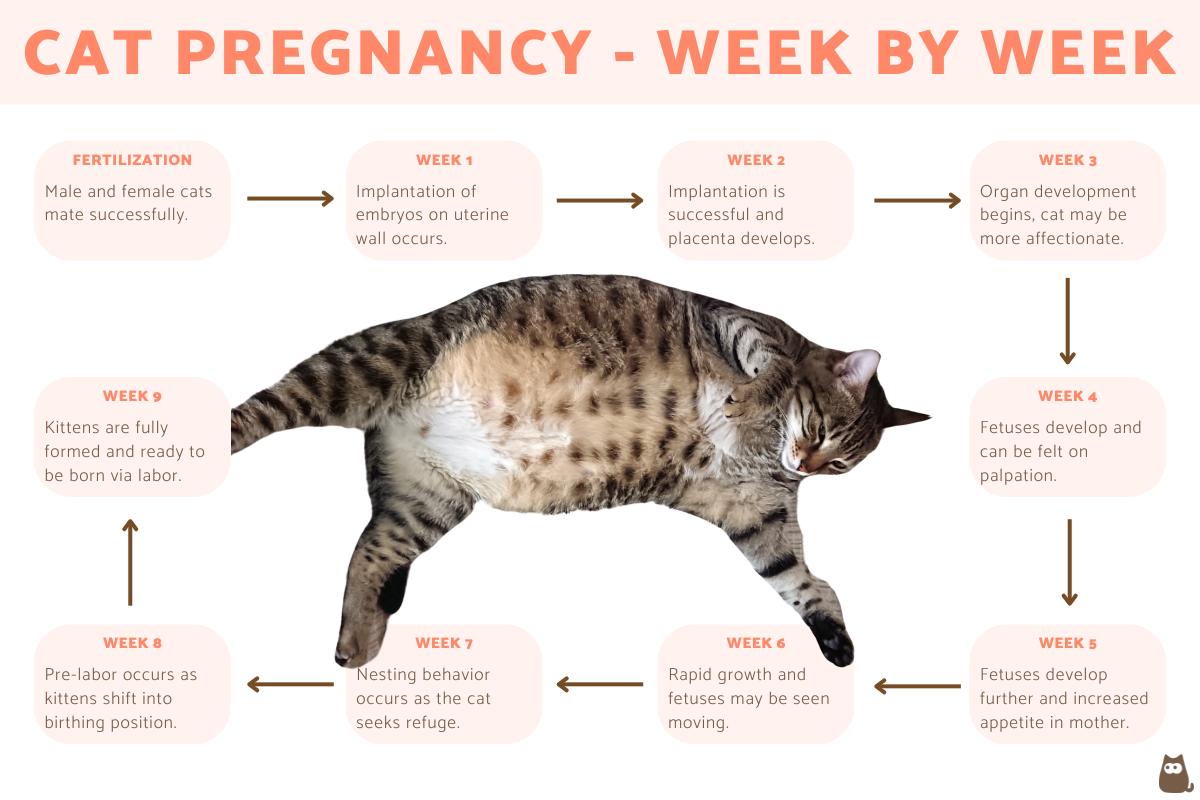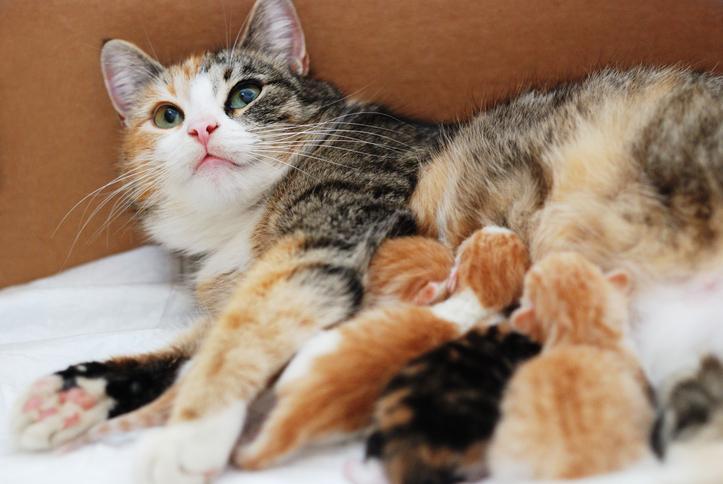Cat Pregnancy Period - Week by Week



See files for Cats
Pregnancy in cats is a very sensitive time. The health of the mother directly influences the health of the young, both of which guardians want to safeguard at all costs. Although we can enjoy this time, we will be relieved when it is over and we know that mother and kittens are safe. To best ensure their well-being, we need to know what to expect every step of the way. Whether we did or did not intend for the cat to get pregnant, safeguarding their health is vital.
This is why AnimalWised explains the cat pregnancy period week by week. We start with how you can tell whether a cat is pregnant, for how long they have been pregnant and how many kittens she might be birthing. However, this is not a replacement for a veterinary checkup which we consider mandatory for a pregnant cat.
How to tell if a cat is pregnant
Before discussing the duration of a cat's pregnancy and its stages, it's important to confirm they are indeed pregnant. The most comprehensive test is an ultrasound at the veterinary clinic. This image testing can tell us not only whether a cat is pregnant, but the stage of embryo development. At a certain point in the pregnancy period, it can even let us know how many kittens are in the litter.
You can purchase home testing pregnancy kits for cats. They can be a little difficult to administer and they are not 100% accurate, but they are a good option. When these are not available or you only have a suspicion, you can look to the signs a cat is pregnant. These include the following:
- Bloated belly
- Swollen breasts
- Vaginal swelling
- Nipple discoloration
- Increased appetite in early stages
- Sleeping more
- Being more affectionate (early stages)
- Being more distant (later stages)
- Nest preparation
The types of behavioral changes often differ according to the stage of cat pregnancy period. Generally speaking, they will look for security and reassurance during the early stages. This is a response to the changes in their body which can be quite confusing, especially for cats which are pregnant for the first time. Pregnant cats will start to look for a safe nesting area in the latter stages of pregnancy. This may result in distancing or even a grump temper.
We provide more background to cat pregnancy with our article explaining at what age cats can have kittens.
How long does a cat pregnancy period last?
Female cats are fertile during certain stages of their estrus cycle, also known as the heat cycle in cats. A cat can enter her first heat cycle at around 6 months of age, although this will depend on individual circumstances. Spring and autumn are typically the times when a cat will come into heat, but a cat can experience heat during multiple periods throughout the year.
When a cat is fertile, she will be desirable by males for mating purposes. After successful copulation and fertilization, the cat will be pregnant. A cat's pregnancy can last anywhere between 58 to 72 days, but generally speaking cats are pregnant for an average of 63-65 days. How long a cat's pregnancy will last will depend on various factors such as their health status, diet, the care they receive and even climatic changes.
Once our cat becomes pregnant, it is important to seek the advice of a veterinary specialist. They will be able to assess the stage of embryo development and test for any health issues which may affect the pregnancy.

How do I know how far along my cat is pregnant?
The duration of a cat's pregnancy is around 8 weeks (c. 64 days), but it can be difficult to determine at what stage the cat is pregnant. Although the cessation of the heat period might imply pregnancy, it is possible the estrus cycle has simple been completed without fertilization. This will be the case if the female cat has not had access to a male.
While veterinarians can confirm pregnancy with an ultrasound, they will only be able to do so after around 20 days. If the pregnancy is unwanted or poses a threat to the health of the mother, it is possible to terminate it at this time. Although a pregnant cat can be spayed, it provides certain health risks which will need to be assessed by the vet.
A cat will start showing more obvious physical changes towards the middle of the pregnancy. The most obvious is an increase in belly size, something which needs to be differentiated from other causes of a swollen abdomen in cats. During the final stages, we should be able to see and feel the kittens moving. In the next section, we look at the cat pregnancy period week by week to have a better idea of what to expect.
Cat pregnancy period week by week
As we have explained, a mother cat will show different physical and behavioral changes during their pregnancy. To have an idea cat pregnancy stage, we take a look at a week-by-week rundown of a cat's pregnancy period:
Stage 1: Fertilization (week 0)
When a female cat is in heat, she will be fertile for around 7-10 days during which mating may occur. Female cats have induced ovulation, meaning they release their eggs due to mating with a male. If fertilization is successful, we will not be able to see any immediate signs of pregnancy. However, we may observe that the signs of the heat cycle in cats are less pronounced.
If the cat is of poor health, there may be risks at this stage, but they will be minimal. More concerning than fertilization would be the mating act itself, especially if it occurs with multiple males. The cat can experience superfecundation which is a single litter of kittens with multiple paternities from different male cats.
Stage 2: Implantation (weeks 1-2)
Now the gametes have carried out fertilization, the embryos are formed. During this stage of cat pregnancy, the embryos move to the uterus where they become implanted on the uterine wall and the placenta begins to form. Symptoms during this stage may include:
- Drowsiness or less energy
- Changes to appetite (increase or decrease)
- Vomiting
Successful implantation can be prevented due to stress, disease, poor nutrition or other factors. This can result in the pregnancy being terminated.
Stage 3: Embryo development (weeks 2-4)
After successful fertilization and implantation, the embryos will start to develop into fetuses. This is a complicated process which involves the formation of organs and other tissues which constitute the organism of the unborn kittens. Symptoms during this stage may include:
- Nipple discoloration
- Increased appetite
- Territoriality
- Greater affection
An increased appetite is due to requiring more energy and nutrients for the developing fetuses. Not providing the right diet can negatively affect their development, but the cat should self-regulate their food intake. In addition to poor diet, exposure to pathogens or parasites can affect embryonic development.
Stage 4: Fetal growth (weeks 4-7)
This is considered the mid-gestation period of a cat's pregnancy. The fetuses will develop tissues such as bones and fur, becoming more recognizable as felines. Towards the end of this cat pregnancy period stage, the kittens may even start moving. Symptoms during this stage include:
- Noticeable weight gain
- Distended belly
- Nipple enlargement
- Increased grooming
- More affectionate
- Nesting behavior
Cats crave security, so they will look for someone safe to give birth. This is known as nesting behavior and it can be helped by use. We cab provide a comfortable and quiet space in which the cat can feel safe. We should interfere as minimally as possible, but also ensure we provide anything she may need such as access to food and water.
Stage 5: Pre-labor (weeks 7-8)
At this stage of cat pregnancy, the kitten fetuses will be fully developed, but they are not quite ready to be born. It can last for an indeterminate period of time, anything between 4-24 hours before labor occurs. Symptoms during this stage include:
- Drop in body temperature by c. 1ºC/2ºF
- Vaginal discharge (clear or slightly bloody)
- Restlessness
- Lactation
- Decreased appetite
- Anxiety
- Increased vocalization
This is a very sensitive time for the cat. She will be at risk of cat labor complications such as premature labor, eclampsia or even infections. While we should not intervene unless necessary, we should observe for any signs of complications. While pre-labor can last up to 24 hours, we need to be very careful if she does not start to enter labor after this time.
Stage 6: Labor (after c. week 8)
Although this is the final stage of the cat pregnancy period, it will be divided into different stages. These are:
- Early labor (6-24 hours): the cat will show symptoms she is about to enter labor such as dilation of the cervix, restlessness, panting, drooling, licking of the genitals and contractions, although these will be difficult to see at this stage.
- Active labor (up to 24 hours after pre-labor): during this time the contractions are visible. The most obvious sign of this period is that the kittens are born. A period of 30-60 mins may occur between the birth of each kitten, although it can be much shorter. Much longer than an hour might suggest complications, but not necessarily.
- Post-birth: each kitten will be delivered within an amniotic sac with the placenta attached. The mother will break open the amniotic sac and eat the placenta. She will then start licking the kittens to clean them and to assess their state of health. Licking also helps to stimulate breathing. Nursing can begin immediately after birth.
Sometimes complications arise in the delivering of kittens. These may include an obstruction, preventing the kitten from passing through the birth canal. In these cases, it is important you contact a veterinarian immediately as it will constitute an emergency. If born stillborn or with serious deformities, it is possible a mother cat will eat this kitten. She does so to protect the rest of the litter.
There may also be reasons why a cat rejects her kittens, but does not eat them. In these cases, we should take the newborn kitten to care for them separately. We can provide milk and other are needs.

How many kittens can a cat give birth to?
There is no fixed number for how many kittens a cat can give birth to. While it is possible a cat can birth only one kitten, this is very uncommon. The average is four, but this number can range from one to six kittens. If the veterinarian determined the number of fetuses during pregnancy, we must count them all after birth. If the number doesn't match, we will need to notify the veterinarian.
If a kitten remains in the birth canal or uterus, the mother cat will start showing signs something is wrong. This can be very dangerous for the cat and her kittens. You will need to speak to the veterinarian who may need to carry out surgery to remove the kitten, whether it is dead or still alive.
Learn more with our article asking how many kittens can a cat have?
How many times a year do cats give birth?
If we don't prevent it through sterilization, a cat can easily have another litter of kittens during the same year period. This will require us assessing the different stages of pregnancy again and ensuring the health of mother and fetuses. Unfortunately, there are many cats born without a loving family to care for them. This results either in an increase in the number of feral domestic cats or their eutanasia by animal control organizations.
Until what age can a cat give birth?
The truth is that there's no age limit for all cats. Depending on the breed and lifestyle, they can reproduce for different numbers of years. Some cats can give birth up to 10 years old, while others can do so up to 17. What's important to know is that continued litters can seriously harm a cat's health and shorten her life expectancy. For this reason, we insist on spaying female cats.

Should I spay my cat?
Female cats are seasonally polyestrous, meaning they will go into heat continuously during the months with the most sunlight. This is generally from late winter to early autumn. They will only stop if fertilization occurs or the estrus cycle has otherwise completed itself.
With such fecundity and the popularity of cats as pets, many kittens are born without access to the right level of care. This results in many cats either being abandoned or killed unnecessarily. There are many breeders who are reputable and have controlled systems for breeding domestic cats safely. Guardians should not breed their cat unless they have good reason to.
It is a popular myth that female cats need to be pregnant at least once for health reasons. This is not true. Moreover, cats will achieve various health benefits when they are spayed. Reproductive diseases such as uterine infections and cancers become more likely as the cat ages. By carrying out an ovariohysterectomy (commonly known as spaying), the cat will eliminate the possibility of developing these problems and increase life expectancy as a result.
Behavioral problems are also minimized when cats are spayed. They will not enter their heat cycle, so they will not try to escape to mate. Their temperament generally becomes more even, especially when they are spayed before they reach sexual maturity. Not only is it advisable to spay your cat, it is a legal requirement in many regions due to the problems caused by large cat populations.
While there are potential risks which can occur when spaying a cat, they are minimal. It is a routine surgical procedure which requires minimal recovery. One of the most important considerations is ensuring their surgical incision does not become infected. Learn more with our article on the cat spay incision healing process.
You can learn more about the importance of spaying with our video below on the advantages and disadvantages of neutering a cat:

If you want to read similar articles to Cat Pregnancy Period - Week by Week, we recommend you visit our Gestation category.
- Sanchez, AE (2002). Gestation biology in the domestic cat (Felis catus) .
- Minovich, FG; Rubio, AM; Sanz, L. (2019). Practical manual of feline medicine . Publisher: Multimedia Veterinary Editions.








